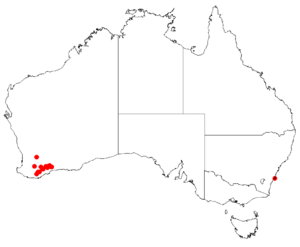Short-winged hakea facts for kids
Quick facts for kids Short-winged hakea |
|
|---|---|
| Conservation status | |
| Scientific classification | |
| Genus: |
Hakea
|
| Species: |
brachyptera
|
 |
|
| Occurrence data from Australasian Virtual Herbarium | |
Hakea brachyptera, also called the short-winged hakea, is a type of bush found in Western Australia. It belongs to a plant family called Proteaceae. You can find it growing in the southern parts of the Wheatbelt and Great Southern regions.
About the Short-Winged Hakea
Hakea brachyptera is a small, bushy plant that grows up to about 1 metre (3.3 feet) tall. It has many branches that twist together and look a bit rusty in colour.
Its leaves are thin, round, and stiff. They are usually between 3 and 9.5 millimetres (0.12 to 0.37 inches) long and 0.7 to 1.3 millimetres (0.03 to 0.05 inches) wide. These leaves are covered in fine, tangled hairs and end with a very sharp point.
Small groups of 1 to 5 white flowers grow along the stems where the leaves join. Each flower has a small stalk, called a pedicel, which is about 1.5 to 2.5 millimetres (0.06 to 0.10 inches) long and covered in silky hairs.
After the flowers, the plant grows round fruits. These fruits stick out from the stems and are about 2 centimetres (0.79 inches) long and 2 centimetres (0.79 inches) wide. They are a bit flat and have a rough surface. This hakea can also handle cold weather and frost well.
Naming and History
The scientific name for this plant, Hakea brachyptera, was first officially written down by a scientist named Carl Meisner in 1856. He published his description in a book by Alphonse Pyramus de Candolle called Prodromus Systematis Naturalis Regni Vegetabilis.
The second part of its name, brachyptera, comes from two Ancient Greek words. Brachys means "short" and pteron means "wing" or "fin". This part of the name describes the shape of the plant's seeds.
Where It Grows
You can find Hakea brachyptera in the southwest part of Western Australia. It grows in areas from near Wagin to Lake Magenta and south towards the Stirling Range.
This plant likes to grow in places where the soil drains well. It prefers sunny spots with sandy loam, clay, or gravel soils.
Protecting This Plant
Hakea brachyptera is listed as "Priority Three" by the Government of Western Australia's Department of Parks and Wildlife.
This means that the plant is rare or close to being threatened because it only grows in a few specific areas. Protecting these areas helps keep the short-winged hakea safe for the future.


